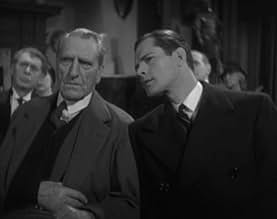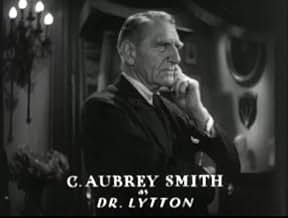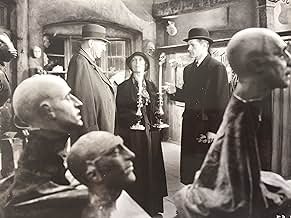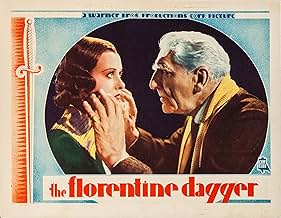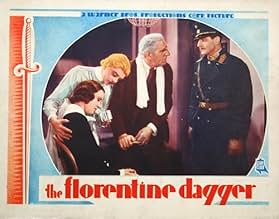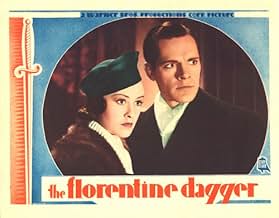Juan Cesare, a descendant of the Borgias of Vienna, thinks he may have a murder streak in him acquired from his long-dead relatives, is is love with Florence Ballau, but her father lodges a ... Read allJuan Cesare, a descendant of the Borgias of Vienna, thinks he may have a murder streak in him acquired from his long-dead relatives, is is love with Florence Ballau, but her father lodges a strong protest. Victor Ballau is later found dead with a Florentine dagger of the Borgia t... Read allJuan Cesare, a descendant of the Borgias of Vienna, thinks he may have a murder streak in him acquired from his long-dead relatives, is is love with Florence Ballau, but her father lodges a strong protest. Victor Ballau is later found dead with a Florentine dagger of the Borgia type stuck firmly in him. Juan is all wrought up and tortured by thoughts he may have been ... Read all
- Director
- Writers
- Stars
- Bartender
- (scenes deleted)
- Newspaper Editor
- (scenes deleted)
- Eric - Night Watchman
- (uncredited)
- Detective
- (uncredited)
- Director
- Writers
- All cast & crew
- Production, box office & more at IMDbPro
Featured reviews
Oddball little movie, not quite a whodunit since the suspects are too under-developed to pick through. The result is more like an early noir with Cesare (Woods) struggling against dark forces and maybe fate, too. In fact, I'll bet the lighting bill didn't exceed 5 bucks. Also, I'm with the reviewer pointing out that Woods lacks the expressive depth to play the central character effectively. Too bad, because that would have made the movie more memorable. On the other hand, there's the craggy-faced Aubrey Smith as a commanding head doctor, and a most un- cop-like Robert Barrat as chief cop. And what about actress Eily Malyon whose close-ups are enough to scare off both Karloff and Lugosi.
All in all, I'm not sure the movie knows where it wants to go. The threads do not blend well. Still, there are some creepy moments that manage to compensate. Then too there's that surprise ending where justice happily triumphs over law. Looks like the screenplay (1935) managed to sneak this by a newly installed Production Code (1934). Anyway, my guess is that when Barrat leaves the airport he's headed to the Playboy Club no matter what he's told the wife.
** (out of 4)
Yet another murder/mystery with this time a young play-write (Donald Woods) stopping off in a small village where he meets a beautiful young woman (Margaret Lindsay) who he wants in his latest play. Soon the play is a hit and they want to be married but her father (Henry O'Neill) refuses permission but soon he's found dead with a dagger in his heart. That's pretty much the set-up to this thing but in the end I found the majority of the picture to be downright boring with very little going for it. I've always thought Florey did his best work outside this genre as it just seemed like he never could pull things together very well. I think the biggest problem with this film isn't his direction but instead it's the screenplay that doesn't offer up any decent characters and the weak story is just a major drag. I had a very hard time getting into the film early on simply because the characters were all underwritten and even worse is the fact that the movie itself doesn't really know what it wants to do. Yes, we eventually get the mystery but everything is pretty dry without any small laughs and the romance is pretty boring as well. Woods is usually a very reliable actor but even he seems very bored here as he goes from one scene to another without too much energy and seems to be lacking any type of passion. Lindsay is also pretty bland in his role but so is O'Neill as the soon-to-be-dead father and Robert Barrat does very little with the Inspector role. C. Aubrey Smith is good as the doctor who ends up staying close to Woods. Florey does add a couple nice touches including a rich atmosphere in the house as well as a few other scenes where the darkness does some justice but in the end this thing is just too flat for its own good.
The story starts with three visitors to the famous abandoned castle of the Borgias in Italy. One is producer Victor Ballau (Henry O'Neill), another is psychiatrist Gerard Lytton (C. Aubrey Smith), and a third is a troubled young man (Donald Woods) who is the last of the Borgias - his namesake is Cesare Borgia to whom he bears a remarkable likeness. The troubled young man, Juan Cesare, attempts suicide to prevent himself from becoming a murderer when he feels the Borgia urge to kill rise up in him. Fortunately his attempt is thwarted by Dr. Lytton. Instead, Juan goes to Vienna where he recovers from his obsessions with his heritage and writes a play for Ballau that is about the Borgias. Juan cannot find the perfect Lucrezia Borgia for his play until he meets Ballau's step-daughter Florence (Margaret Lindsay). The long and short of it is that Victor Ballau winds up dead in his study one night, stabbed to death with one of the Florentine daggers he possesses that once belonged to the Borgias. There are many suspects, and the mystery has many unexpected twists and turns and for that matter, many improbabilities.
One of the goofiest and best things about this film besides its campy dialogue is Robert Barrat's performance as Police Inspector Von Brinkner who is in charge of the murder investigation. Von Brinkner's not a threatening kind of fellow at all, and he's given to all kinds of appetite, usually found to be chewing on brie and the finest food he can scrounge when he isn't chewing scenery, or talking to his girlfriend on the phone. However he turns out to be surprisingly competent and generous. Watch and find out what I mean.
One thing you'll probably note is the precode ending a full year after the production code went into effect. Again, you'll have to watch to find out what I mean, but I just don't know how the censors let this ending stand as it did.
When O'Neill becomes the victim of a stabbing, the plot thickens as Detective Von Brinkner (ROBERT BARRAT) goes about trying to solve the crime. But it's really C. AUBREY SMITH who does most of the snooping to uncover the reason behind O'Neill's vicious death.
However, it's Barrat's lively performance as the playboy detective that gives a lift to the story and a bit of humor that's badly needed.
It's really a B-film struggling to look like an A-film with some proper atmosphere and period settings, but the story is told in dull fashion and never quite becomes as fascinating as the film's imaginative title.
Very atmospheric for such a small film with some good performances, particularly by Robert Barrat as a police inspector who's quite funny. Lindsay is miscast as this mysterious, goddess-like woman whose performance is the talk of Vienna. A Greta Garbo role in the hands of Margaret Lindsay, a completely different type.
A short film, fairly well done given the budget.
Did you know
- TriviaWarner Bros. created the advertising marketing ploy "Clue Club" to increase audiences attending its crime mystery/drama movies. Twelve titles showing the Warner Bros. "Clue Club" promo footage were released from 1935 to 1938.
Clue Club #1: The White Cockatoo (1935)
Clue Club #2: While the Patient Slept (1935)
Clue Club #3: The Florentine Dagger (1935)
Clue Club #4: The Case of the Curious Bride (1935)
Clue Club #5: The Case of the Lucky Legs (1935)
Clue Club #6: The Murder of Dr. Harrigan (1936)
Clue Club #7: Murder by an Aristocrat (1936)
Clue Club #8: The Case of the Velvet Claws (1936)
Clue Club #9: The Case of the Black Cat (1936)
Clue Club #10: The Case of the Stuttering Bishop (1937)
Clue Club #11: The Patient in Room 18 (1938)
Clue Club #12: Mystery House (1938)
Details
- Release date
- Country of origin
- Languages
- Also known as
- Clue Club #3: The Florentine Dagger
- Filming locations
- Production company
- See more company credits at IMDbPro
- Runtime
- 1h 9m(69 min)
- Color
- Sound mix
- Aspect ratio
- 1.37 : 1

